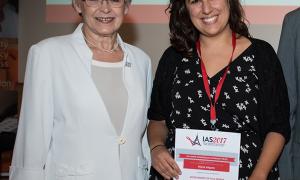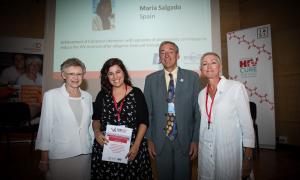IrsiCaixa researcher Maria Salgado awarded at the conference of the International AIDS Society

The $5,000 Dominique Dormont Award recognizes the scientific work of young researchers at the IAS 2017 Conference. Salgado presents an abstract focused on the study of six patients included in the IciStem project, an international consortium to investigate the potential for HIV cure by stem cell transplantation.
IrsiCaixa researcher Maria Salgado has been selected to the Dominique Dormont Award, to be awarded at the 9th IAS Conference on HIV Science (IAS 2017) in Paris to recognize the work of young researchers under 40 years of age. The US$ 5,000 award is funded by the Dominique Dormont Association to support young researchers working on chronic conditions in humans, with a particular focus on the interface between HIV and other chronic diseases. Dr. Salgado will receive the prize during the IAS Members Meeting and Joep Lange Memorial Lecture, today in Le Grand Amphithéâtre. Her work at the conference analyses factors related to stem cell transplantation that may influence a potential cure for HIV infection.
Dr. Salgado’s research focuses on six patients included in the IciStem project, an international consortium to investigate the potential for HIV cure by stem cell transplantation. Funded by The Foundation for AIDS Research, amfAR (USA), IciStem was created after The Berlin Patient case: Timothy Brown, a HIV-positive man that in 2008 received a stem cell transplantation with a mutation, so-called CCR5 Delta32, which averted the virus from infecting the cells. After the transplantation, virus began to disappear in his body. Today he is cured of the cancer and is considered the only person cured of HIV infection.
Aiming to eliminate the reservoir
IciStem studies HIV infected patients who receive stem cells from another person (allogeneic stem cell transplantation) because of life-threatening hematological conditions, in order to figure out what conditions, besides the CCR5 Delta 32 mutation, contributed to Brown’s cure. 23 patients have been included in the study until now. Dr. Salgado presents at IAS 2017 a work focused on six of them, who have been followed up for more than 2 years and received and allogeneic stem cell transplantation without the CCR5 Delta 32 mutation. Scientists analysed their reservoir, which are infected cells that remain dormant so the immune system cannot detect and destroy them. The reservoir is currently considered the main obstacle to find a cure for HIV.
Five out the six individuals reduced their reservoir to apparently undetectable levels. “We cannot say that the virus has been eliminated until we stop antiretroviral treatment because HIV infects again when drugs disappear, but with current techniques we have not been able to find viral reservoirs in either blood or tissue,” Salgado explains. “At the moment, stem cell transplantation is the only medical intervention that achieved this reduction -says Javier Martínez-Picado, ICREA researcher at IrsiCaixa and head of Dr. Salgado’s group-. This encourages us to further investigate what happened in those reservoirs after the intervention,” he adds.
Potential factors to eradicate the virus
Other factors studied by scientists are the prior therapies to transplantation, the possible reaction of the donor's immune system against the one of the recipient, the compatibility degree between both and time needed to achieve the complete replacement of the recipient’s cells.
IciStem is co-led by Martínez-Picado and Annemarie Wensing, clinical virologist at University Medical Center Utrecht (The Netherlands). Researchers insist that stem cell transplantation is a high-risk procedure, with a mortality of 50% approximately, so it is performed only in situations where there is no other therapeutic option to treat cancer. “We aim to investigate factors that help to eradicate the virus and then mimic them to design new HIV cure strategies, alternatives to transplantation,” Salgado concludes.
